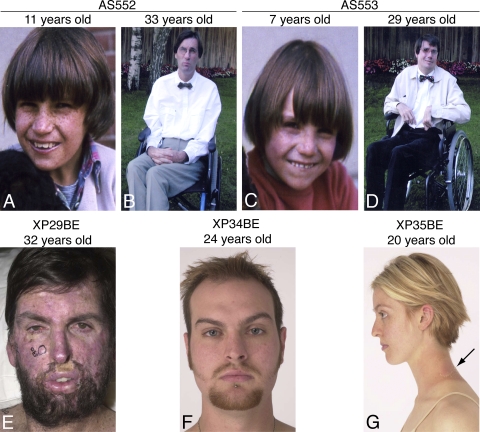Figure 1.
XP patients studied. (A and B) Patient AS552. (A) At 11 yr of age he had marked freckle-like hyperpigmentation in sun exposed portions of his face and neck. (B) By age 33 yr he used a wheelchair because of his inability to walk. He died at age 39 yr of progressive neurological degeneration. (C and D) Patient AS553, brother of AS552. (C) At 7 yr of age he had marked freckle-like hyperpigmentation in sun exposed portions of his face. (D) By 29 yr of age he used a wheelchair because of his inability to walk. He had posturing of his hands, a feature of neurodegeneration. He died at age 35 yr of progressive neurological degeneration. (E) Patient XP29BE at 32 yr of age. He has marked freckle-like hyperpigmentation in sun exposed portions of his face and neck. His face shows extensive scarring and grafting from numerous surgical procedures for removal of skin cancers. The circled lesions on his face and shoulder were being followed photographically for signs of skin cancer. His conjunctiva show telangiectasia. He died at age 37 yr of progressive neurological degeneration. (F) Patient XP34BE. He was well protected from sun exposure and at age 24 yr he had minimal freckle-like hyperpigmentation on his face and neck and no skin cancers. By age 31 yr he had no evidence of neurological degeneration. (G) Patient XP35BE, younger sister of patient XP34BE. She was well protected from sun exposure and at age 20 yr she had minimal freckle-like hyperpigmentation on her face and neck and no skin cancers. Brief sun exposure of an unprotected portion of her neck resulted in an acute sunburn followed by hyperpigmentation, scaling and peeling of the skin (arrow). By age 27 yr she had no evidence of neurological degeneration.

